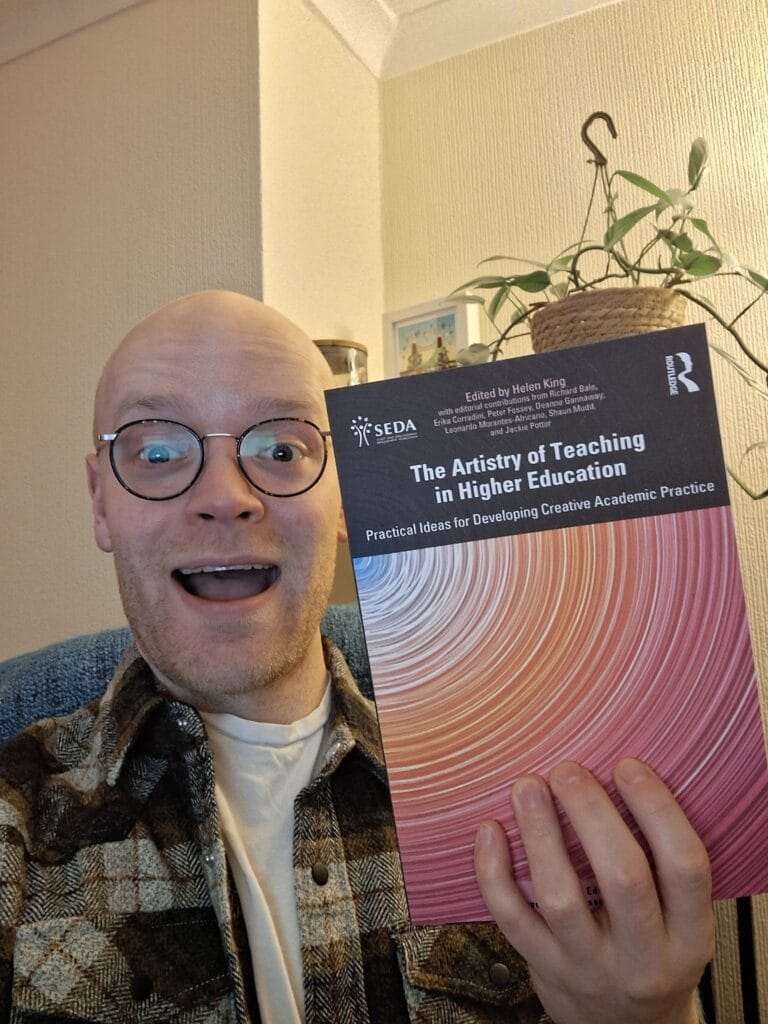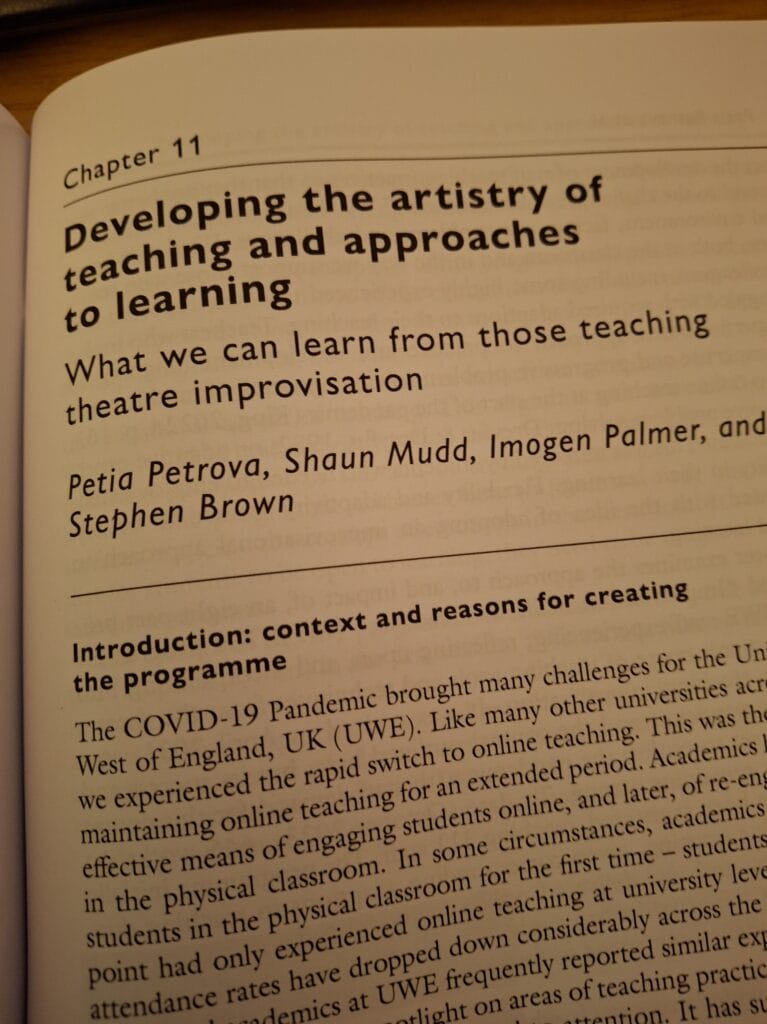Sometimes life takes you to unexpected places, and those places can be both thrilling and meaningful. I’ve had many changes in my personal life recently, one of which is fulfilling a life-long dream of mine.
I’m over the moon to share that I’ve been featured in a book for the very first time! 🎉 The book, The Artistry of Teaching in Higher Education, is a collection of practical and creative ideas designed to inspire and elevate university teaching practices, specifically aimed at university educators looking to enhance their teaching with creative approaches. One of the chapters focuses on a course that my friend Imo and I created together at the Bristol Improv Theatre called “Improv Skills for Teaching,” designed specifically for university educators who are looking to enhance their teaching with creative techniques.
It feels incredible to see the work that we’ve done being recognised in this way. The chapter I contributed to, written by colleagues from UWE Dr Petia Petrova and Dr Shaun Mudd, explores how improvisational theatre techniques can be used to support effective and engaging teaching practices. We’re talking about building rapport, embracing imperfection, and creating spaces where everyone—students and teachers alike—can be brave. The kind of space where learning feels not just possible, but joyful.

For more information on how you can incorporate improv principles into your everyday working life, check out my blog post on ‘Improv Skills for Work‘.
✨ The Spark
The journey started, like many good stories, in a moment of crisis: the pandemic. Universities had to pivot quickly to online teaching, and as anyone who had to shift their training, workshops, or teaching online will tell you, it wasn’t easy. For both students and educators, it was a challenging time that highlighted a deep need for connection, spontaneity, and flexibility. Suddenly, teaching required much more than just knowledge—it required a sense of artistry. That’s where our work with improvisation came in.
Petia was taking an online improv class at the time and began wondering how the principles of improv could translate into the online learning environment. We saw an opportunity to take the tools we’d been using on stage and apply them to the (now virtual) classroom. The skills we’d honed in improv—building trust, supporting each other, and embracing the unexpected—felt tailor-made for this new teaching environment. And so, “Improvisation Skills for Teaching” was born, a programme that invited educators to step outside their comfort zones, to be playful, and to reconnect with their own joy in teaching.
🗺️ The Journey
Working with Petia and Shaun, we developed and delivered the programme to staff at UWE (University of the West of England) and beyond. Since launching, we’ve run this programme for 13 cohorts, with the 14th coming up soon. Furthermore, it has reached educators at UWE, the University of Bristol, and St. George’s in London. It’s been an incredible ride, filled with laughter, growth, and some surprising revelations.
What’s so special about this programme is how it reminds us that education isn’t just about knowledge transmission – it’s about human connection (as anyone who has experienced a presentation where the person just reads off the slides will be able to attest to!). It’s about making the classroom a space where everyone feels they belong, even when everything is uncertain. And it turns out, improvisational theatre provides the perfect toolkit for that.
🔦 The Spotlight on Improv Skills for Teaching
So now, here we are, a few years after it all started, and our work has found its way into a book! The Artistry of Teaching in Higher Education is for educators looking to bring more creativity, connection, and authenticity into their teaching practice. It’s a guide for those who want to go beyond the traditional and embrace the messiness that often accompanies great teaching.
The chapter on improv skills is full of practical tools that educators can use to make their classrooms more inclusive, responsive, and, most importantly, human. You’ll find activities to help build rapport, encourage active participation, and—my personal favourite—embrace the value of getting it wrong sometimes. Because, as we teach in the course, we don’t ‘fail’, we ‘happy fail’ – because, if you don’t get things a bit wrong sometimes, are you really learning??
✅ Key Takeaways from the Chapter

If you pick up the book (and I highly recommend you do if you’re interested in the art of teaching), here’s what you can expect from the chapter I contributed to:
- Creating Positive Learning Environments: How to foster bravery and connection between students and educators, and why it’s essential to have the freedom to get things wrong.
- Your Voice and Presence: Using improvisation to enhance communication skills, be authentic, and make genuine connections in the classroom.
- Reframing the Teacher-Learner Dynamic: Approaching your teaching from an improv perspective allows you to remove the pressure from yourself as ‘teacher’ and ‘all-knowing-Yoda’ to a partner in the learning environment with the student.
Conclusion
This moment is a “pinch-me” moment—because being published is something I’ve dreamed about, and here it is, in black and white. But it’s also a moment where people are beginning to recognise the tools of play, connection and engagement can be used, and might even be essential, to domains outside of the improv theatre.
So, if you’ve ever wondered how improv can make you a better teacher—or just how it might make you more comfortable with life’s curveballs—please check out The Artistry of Teaching, or get in touch with me here or at the Bristol Improv Theatre to see how we might be able to work together!
Speak soon,
Ste 🍵
| If you’re interested in personal development and self-improvement, why not sign up for my monthly(ish) newsletter where you’ll find practical tips and join a budding community of improvers? |
